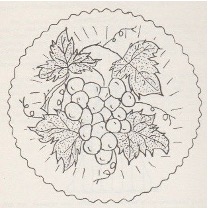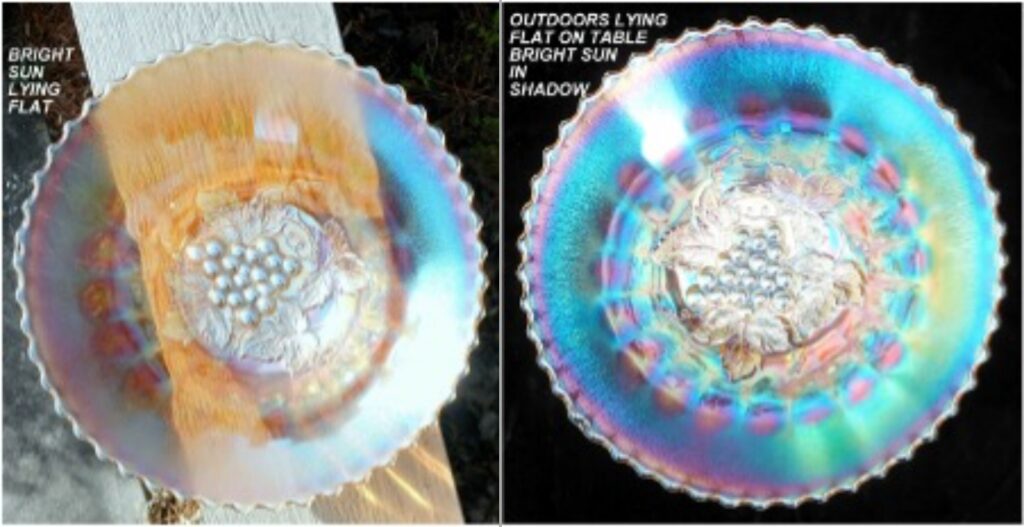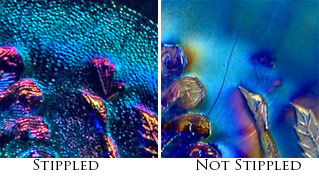Malaga
By Dr. Larry Keig
Malaga is the least known of Dugan-Diamond’s grape patterns. Named by Marion Hartung, Malaga is a large white grape grown in a region of southern Spain. Malaga is located about a hundred miles southwest of Seville. The grapes are mostly used to make a fortified sweet wine.
The principal elements of the pattern are a single large grape cluster in the center and four large veined and stippled leaves, with parts of the leaves masked by grapes. The grapes, leaves, and tendrils are set over 28 slightly raised half-inch wide arched ribs which extend outward to just over an inch from the serrated edge. Mrs. Hartung’s line drawing (Book Six, p. 63) clearly show the principal elements but only suggests the existence of the ribs. In the line drawing, the pattern defining elements occupy too great a proportion of the space, the ribs not enough. The exterior and underside of the collar base are unpatterned.

Hartung’s drawing is shown above.
Based on the known colors, color quality, and reported iridescent effects, Malaga is probably a Diamond pattern, made well after the Dugan era. A best guess for date of manufacture is a short period between 1920 and 1925.
Shapes
Malaga is a hard-to-find pattern in all available shapes. Dave Doty has a total of eight Malaga items listed in his multi-year database. A few others have sold on eBay and other online auction sites.
Bowls. Bowls are available in non-ruffled round (or flared) versions. They have been reported only in marigold and amethyst. Three of the five listed in the Doty database are marigold. The other two are amethyst. One of the three marigold is deep flared; the other two are round. Both of the amethyst are deep round. The top diameters of bowls range from eight to nine and one-half inches. The base diameter is three and one-half inches.
The base color of the illustrated non-ruffled deep round bowl is a very pale even marigold. But its base color is not what distinguishes this especially lovely example from pedestrian pieces in this pattern. Rather, it’s the quality of iridescence and nature of the surface effect. The iridescence is pastel, mostly celeste blue and ice green with pink around the outer edge. Its surface is stretchy. Its top diameter spans about eight inches. It stands approximately five inches tall.

The pale marigold Malaga bowl, left, with beautiful pastel iridescence. Photo, taken in indirect light, is courtesy of Ray and Dawn Ducharme.
Photo of the Malaga bowl, right, taken in such a way as to show the pale marigold base color along with the iridescence.
This bowl sold on an eBay auction in March 2019. It was offered by Ray and Dawn Ducharme who, before moving to North Carolina, lived in upstate New York near and, after being introduced to each other by their school-age daughters, became friends with the carnival legend Tom Burns. There, Ray listed items on eBay for Tom in exchange for him teaching them about carnival. At one time, this piece reportedly belonged to a well-known carnival collector.
Rose Bowls. Rose bowls hardly ever surface. None are listed in the Hooked on Carnival Pricing Database as having sold. [Update: As of 8-21-23 one is recorded as selling on Hooked on Carnival.] Dave Doty lists two marigold as changing hands at major auctions, one in 1996 and the other two years later. [Update: another marigold sold in 2022.]
Carl and Eunice Booker own two. One is marigold, the other amethyst. Their marigold has a top opening of five and one-fourth inches and a height of three and one-half inches. The top opening of the amethyst is five and three-eighth inches and the height three and seven-eighth inches. Their base diameters are identical at three and seven-eighth inches. Measurements of other examples may differ slightly. The amethyst may be an only-known.

Carl and Eunice Booker’s Malaga rose bowls in marigold and amethyst. The amethyst may be an only-known.
Nut Bowls. Only one Malaga nut bowl has been reported as having sold in the past 25 years. In marigold, it has a top diameter of seven inches. It brought a measly $25 at the 2009 Lincoln Land convention auction. As opposed to rose bowls with tops that are cupped in, the nut bowl has essentially straight-up sides. The sides and the surface on which it sits are thus basically perpendicular.

The only known Malaga nut bowl, in marigold, sold for a pittance at a Lincoln Land auction a decade ago. Photo courtesy of the Bookers via Dave Doty.
Desirability
Malaga is a rare pattern, but it is not usually considered highly desirable. Why this is so remains unclear. Prices realized at advertised auctions have varied widely for items with little noticeable differences in quality of color. Desirability is a complex phenomenon. It includes rarity but is not limited to numbers alone. It also includes elegance or uniqueness of design, the base color, quality of color (base or surface, iridescence, and, where applicable, opalescence), range of colors available (usually the greater the range, the more in demand), and size and shape (the larger and smaller and the more unusual generally more desirable than the more conventional). The “common wisdom” of a collector oligarchy often enters in as well.
Malaga is a nice enough design, if perhaps confined too much toward the center of the limited number of shapes in which it is available. The base color and iridescence of those which have changed hands is usually anything but spectacular, although the correlation between the wide range of prices brought and quality of color is only moderately positive. They are available, as noted, in a limited number of colors, staples of the early Diamond years, not the more robust Dugan base colors that are sought by discerning collectors or the alluring iridescent colors introduced by Diamond post-1920.
If a Malaga in a previously unknown Diamond color of the early 1920s—say white with any finish, Egyptian Luster, stretchy blue (blue crackle), or wisteria—were suddenly to appear, it would surely be more desirable than the currently known shades. White is a possibility, as a frosty white Standard vase and a standard white Mae West candlestick have surfaced in recent months and a stretchy white Coin Spot compote sold in early 2018. Any of the other colors just mentioned would be a great find. Collectors ought to dream big.
This article first appeared in the ICGA Pump in the June 2019 issue and is reprinted with permission.

